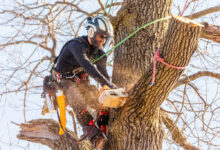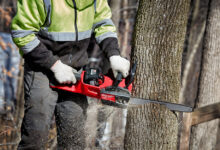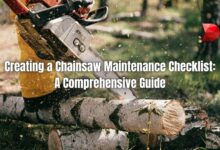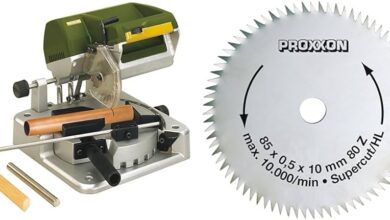Contents
- 1 Introduction: The Importance of Proper Chain Tension
- 2 Understanding Chain Tension: A Balancing Act
- 3 Determining Proper Chain Tension: A Step-by-Step Guide
- 4 Maintaining Optimal Chain Tension: A Regular Task
- 5 Benefits of Proper Chain Tension: A Recipe for Success
- 6 Consequences of Improper Chain Tension: A Cautionary Tale
- 7 Table: Chainsaw Chain Tensioning Parameters
- 8 Frequently Asked Questions on Chainsaw Chain Tensioning
- 8.1 1. How often should I check and adjust chain tension?
- 8.2 2. What are the signs of improper chain tension?
- 8.3 3. How do I adjust chain tension on a chainsaw?
- 8.4 4. Is it safe to operate a chainsaw with improper chain tension?
- 8.5 5. What are the consequences of excessive chain tension?
- 8.6 6. What are the consequences of insufficient chain tension?
- 8.7 7. Can I tension a chainsaw chain without tools?
- 8.8 8. What type of wrench is used to adjust chainsaw chain tension?
- 8.9 9. How do I know when the chain is properly tensioned?
- 8.10 10. Can I over-tension a chainsaw chain?
- 8.11 11. What are the safety precautions to follow when adjusting chainsaw chain tension?
- 8.12 12. Can I adjust the chain tension while the chainsaw is running?
- 8.13 13. Is chain tension the same for all chainsaws?
- 9 Conclusion: The Key to Chainsaw Mastery
Introduction: The Importance of Proper Chain Tension
As a homeowner or professional arborist, maintaining a sharp and properly tensioned chainsaw chain is crucial for efficient and safe operation. Optimal chain tension ensures smooth cutting, reduces wear and tear on components, and prevents the chain from derailing or breaking. In this comprehensive guide, we will explore the intricacies of chainsaw chain tensioning, providing detailed tips and tricks to help you achieve the perfect tension for your specific chainsaw model and cutting needs.
Understanding Chain Tension: A Balancing Act
Chain tension refers to the tightness of the chain as it wraps around the guide bar and sprocket. Too much tension can put excessive strain on the chain, guide bar, and other components, leading to premature wear or damage. Conversely, too little tension can cause the chain to derail or slip off the guide bar, creating a hazardous situation. Achieving the optimal tension requires a delicate balance that considers factors such as chain length, bar size, and cutting conditions.
Determining Proper Chain Tension: A Step-by-Step Guide
To determine the proper chain tension for your chainsaw, follow these simple steps:
- Wear appropriate safety gear, including gloves, eye protection, and hearing protection.
- Disconnect the spark plug to prevent accidental starting.
- Hold the chainsaw with one hand on the front handle and the other on the rear handle.
- Gently pull the chain away from the guide bar in the middle of the bar.
- The chain should have about 1/4 to 1/2 inch (6 to 12 mm) of play between the bottom of the chain and the bottom of the guide bar.
- If the chain has too much play, tighten the tensioning screw located on the side of the saw.
- If the chain is too tight, loosen the tensioning screw until the desired play is achieved.
Maintaining Optimal Chain Tension: A Regular Task
Chain tension can change over time due to factors such as chain stretch, wear, and temperature changes. It’s essential to check and adjust the chain tension regularly, especially after prolonged use or before each cutting session. By following the steps outlined above, you can ensure that your chainsaw’s chain is always properly tensioned for optimal performance and safety.
Benefits of Proper Chain Tension: A Recipe for Success
Proper chain tension offers numerous benefits that enhance the overall cutting experience and longevity of your chainsaw:
- Smooth Cutting: Optimal tension reduces friction between the chain and guide bar, resulting in smoother cutting and less effort required.
- Reduced Wear and Tear: Correct tension minimizes excessive stress on components, extending the life of the chain, guide bar, and sprocket.
- Prevents Chain Derailment and Breakage: Proper tension ensures the chain stays securely in place, reducing the risk of derailing or breaking, which can lead to injury or damage.
- Improved Safety: A correctly tensioned chain reduces the likelihood of kickback, a dangerous phenomenon that can occur when the tip of the guide bar contacts an object.
- Enhanced Cutting Efficiency: Optimal tension allows the chain to cut more efficiently, resulting in faster and cleaner cuts.
Consequences of Improper Chain Tension: A Cautionary Tale
Neglecting proper chain tension can have detrimental consequences for your chainsaw and your safety:
- Premature Component Wear: Excessive or insufficient chain tension can accelerate wear on the chain, guide bar, and sprocket, shortening their lifespan.
- Increased Risk of Derailment and Breakage: Loose chains are more prone to derailment, while overly tight chains can increase the risk of breakage.
- Reduced Cutting Performance: Improper tension affects cutting efficiency, leading to slower and less precise cuts.
- Enhanced Kickback Potential: Chains that are too loose or too tight can increase the likelihood of kickback, posing a safety hazard.
- Safety Concerns: Derailed or broken chains can cause injury to the operator or bystanders.
Table: Chainsaw Chain Tensioning Parameters
| Parameter | Optimal Range |
|---|---|
| Chain Tension (from bottom of chain to bottom of guide bar) | 1/4 to 1/2 inch (6 to 12 mm) |
Frequently Asked Questions on Chainsaw Chain Tensioning
1. How often should I check and adjust chain tension?
For optimal performance and safety, check chain tension regularly, especially after prolonged use or before each cutting session.
2. What are the signs of improper chain tension?
Loose chains may exhibit excessive play, while overly tight chains restrict movement or produce a whining noise.
3. How do I adjust chain tension on a chainsaw?
Locate the tensioning screw on the side of the saw and tighten or loosen it using a wrench or screwdriver until the desired tension is achieved.
4. Is it safe to operate a chainsaw with improper chain tension?
No, improper chain tension can compromise safety and reduce cutting performance. Always adjust the chain tension before using the chainsaw.
5. What are the consequences of excessive chain tension?
Overly tight chains can put excessive strain on the chain, guide bar, and sprocket, increasing the risk of damage or breakage.
6. What are the consequences of insufficient chain tension?
Loose chains are more prone to derailment and can reduce cutting performance due to decreased cutting efficiency.
7. Can I tension a chainsaw chain without tools?
While some chainsaws have tool-free tensioning mechanisms, most models require a wrench or screwdriver for adjustment.
8. What type of wrench is used to adjust chainsaw chain tension?
Typically, a socket wrench or combination wrench is used to adjust the tensioning screw on a chainsaw.
9. How do I know when the chain is properly tensioned?
The chain should have about 1/4 to 1/2 inch (6 to 12 mm) of play between the bottom of the chain and the bottom of the guide bar.
10. Can I over-tension a chainsaw chain?
Yes, excessive tension can put strain on the chain and components, increasing the risk of damage or breakage.
11. What are the safety precautions to follow when adjusting chainsaw chain tension?
Wear appropriate safety gear, disconnect the spark plug, and ensure the chain is securely seated on the guide bar.
12. Can I adjust the chain tension while the chainsaw is running?
No, always adjust the chain tension with the chainsaw turned off and the spark plug disconnected for safety reasons.
13. Is chain tension the same for all chainsaws?
No, optimal chain tension may vary depending on the chainsaw model, chain length, and cutting conditions.
Conclusion: The Key to Chainsaw Mastery
Mastering chainsaw chain tensioning is a crucial aspect of chainsaw ownership and operation. By understanding the importance of proper tension, following the detailed steps outlined in this guide, and addressing common issues through the FAQs, you can ensure optimal performance, extended component life, and enhanced safety. Remember, regular maintenance and proper chain tensioning are essential for a long-lasting and efficient chainsaw that will serve you well for years to come.
1. Prioritize Safety: A Prudent Approach
Safety should always be your paramount concern when operating a chainsaw. Wear appropriate personal protective equipment, including gloves, eye protection, and hearing protection. Disconnect the spark plug before performing any maintenance or adjustments to prevent accidental starting.
2. Regular Maintenance: A Path to Longevity
Regular maintenance is the cornerstone of chainsaw ownership. Check chain tension before each use and adjust as needed. Sharpen the chain regularly to maintain cutting efficiency and minimize wear on components. Clean the chainsaw after use to remove debris and ensure smooth operation.
3. Invest in Quality: A Wise Decision
Choosing a high-quality chainsaw from a reputable manufacturer is an investment in performance and durability. Look for chainsaws with features such as automatic oilers and anti-vibration systems for enhanced cutting comfort and reduced fatigue.
4. Embrace Education: A Path to Expertise
Continuously expand your knowledge of chainsaw operation and maintenance. Read the manufacturer’s instructions thoroughly and consult reputable sources for additional information. Share your experiences and insights with other chainsaw users to enhance the collective knowledge base.
5. Seek Professional Assistance: A Valuable Resource
If you encounter any difficulties or have questions beyond the scope of your expertise, don’t hesitate to seek professional assistance from a qualified chainsaw mechanic. They can provide expert advice, perform









